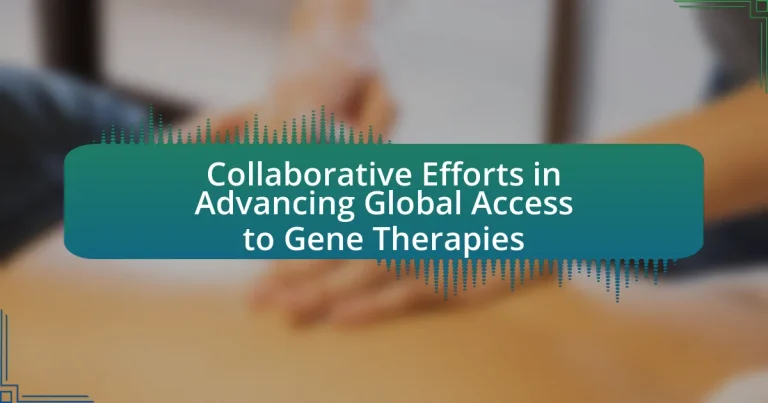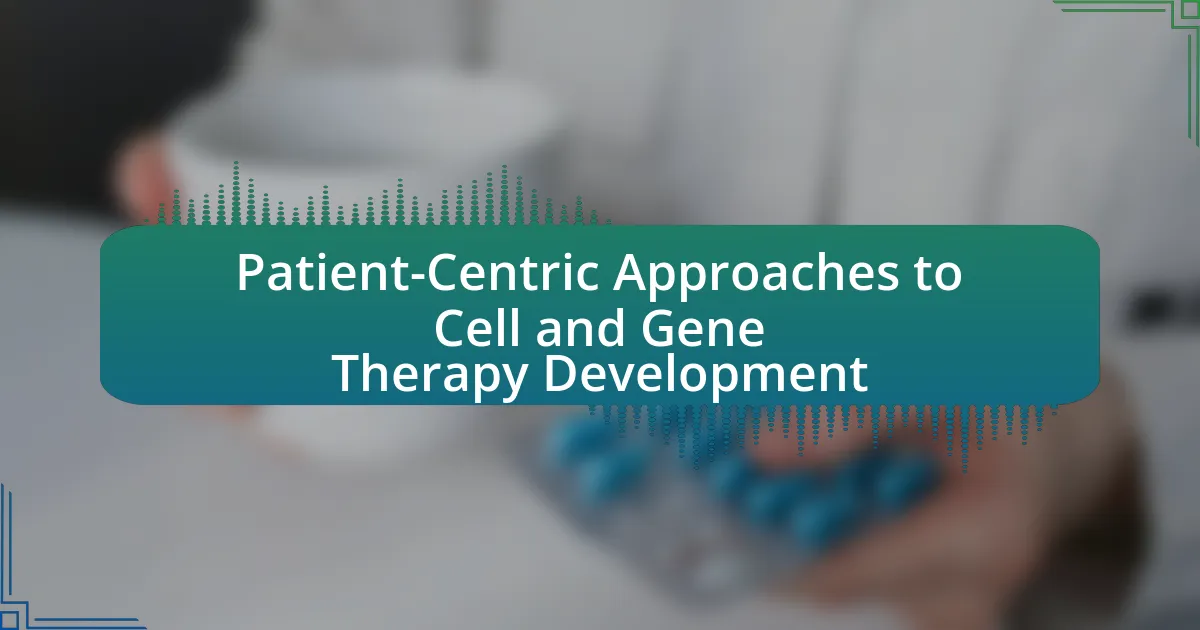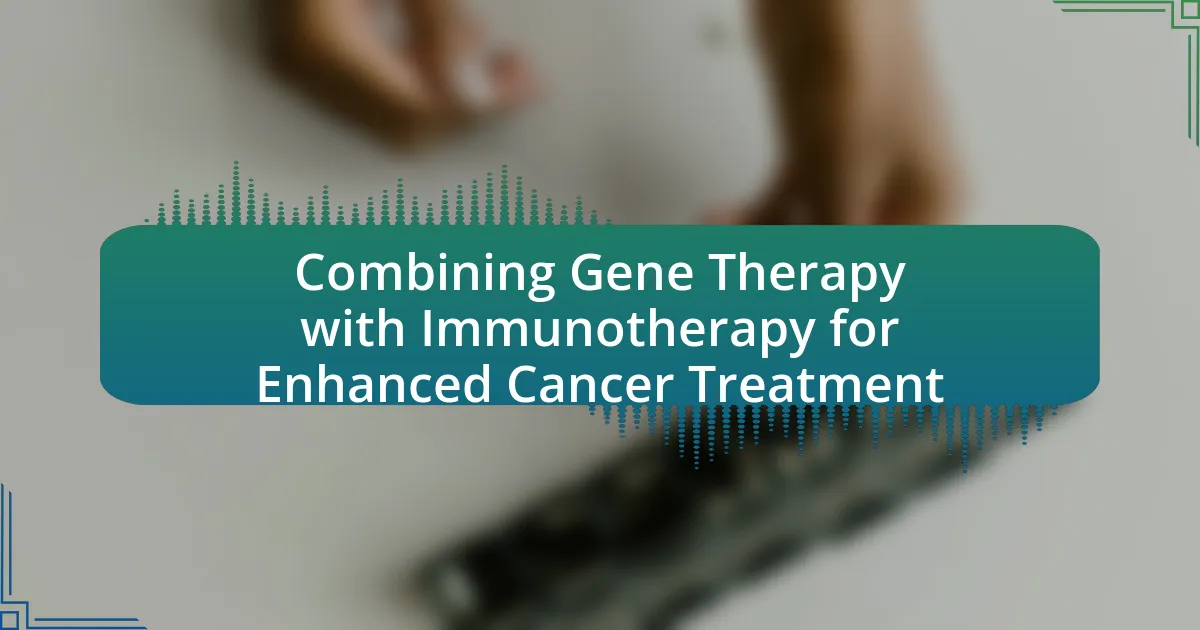Collaborative efforts in advancing global access to gene therapies involve partnerships among governments, non-profit organizations, academic institutions, and the private sector aimed at enhancing the availability and affordability of these treatments. The article outlines the importance of equitable access to gene therapies for improving health outcomes, particularly in low- and middle-income countries, while addressing challenges such as high costs and regulatory hurdles. Key stakeholders, including pharmaceutical companies and patient advocacy groups, play vital roles in these collaborations, which utilize strategies like public-private partnerships and international cooperation to overcome barriers. The article also highlights the impact of technological advancements and best practices in fostering effective communication and resource sharing among stakeholders, ultimately leading to improved patient outcomes and reduced health disparities.

What are Collaborative Efforts in Advancing Global Access to Gene Therapies?
Collaborative efforts in advancing global access to gene therapies involve partnerships among governments, non-profit organizations, academic institutions, and the private sector to enhance the availability and affordability of these treatments. These collaborations aim to address barriers such as high costs, regulatory challenges, and limited infrastructure in low- and middle-income countries. For instance, initiatives like the Global Gene Therapy Consortium work to share knowledge and resources, while organizations such as the World Health Organization advocate for equitable access policies. Evidence of the effectiveness of these collaborations can be seen in programs that have successfully reduced the price of gene therapies through collective bargaining and pooled procurement strategies, thereby increasing patient access worldwide.
Why is global access to gene therapies important?
Global access to gene therapies is important because it ensures equitable treatment for genetic disorders worldwide. Access to these therapies can significantly improve health outcomes, as evidenced by studies showing that gene therapies can cure or alleviate symptoms of previously untreatable conditions, such as spinal muscular atrophy and certain types of inherited blindness. Furthermore, the World Health Organization emphasizes that equitable access to innovative treatments is essential for achieving universal health coverage and reducing health disparities among populations.
What challenges exist in achieving global access to gene therapies?
Achieving global access to gene therapies faces significant challenges, including high costs, regulatory hurdles, and disparities in healthcare infrastructure. The high costs of gene therapies, often exceeding hundreds of thousands of dollars per patient, limit affordability and accessibility, particularly in low- and middle-income countries. Regulatory hurdles arise from varying approval processes across countries, which can delay access to these therapies. Additionally, disparities in healthcare infrastructure mean that many regions lack the necessary facilities and trained personnel to administer gene therapies effectively. These factors collectively hinder the equitable distribution and utilization of gene therapies worldwide.
How do disparities in healthcare systems affect access to gene therapies?
Disparities in healthcare systems significantly limit access to gene therapies by creating unequal availability and affordability of these advanced treatments. For instance, in countries with underfunded healthcare systems, patients may face high out-of-pocket costs, lack of insurance coverage, or limited access to specialized medical facilities, which can hinder their ability to receive gene therapies. According to a study published in the journal “Nature Reviews Drug Discovery,” socioeconomic factors and healthcare infrastructure directly influence the distribution of innovative therapies, with wealthier nations having more resources to invest in gene therapy research and implementation. This results in a stark contrast in treatment accessibility, where patients in low-income regions may not receive potentially life-saving gene therapies due to systemic inequities.
Who are the key stakeholders in these collaborative efforts?
The key stakeholders in collaborative efforts to advance global access to gene therapies include pharmaceutical companies, healthcare providers, regulatory agencies, patient advocacy groups, and research institutions. Pharmaceutical companies play a crucial role by developing and manufacturing gene therapies, while healthcare providers are essential for administering these treatments and ensuring patient care. Regulatory agencies, such as the FDA and EMA, are responsible for approving therapies and ensuring safety and efficacy. Patient advocacy groups represent the interests of patients and help raise awareness, while research institutions contribute to the scientific knowledge and innovation necessary for developing new therapies. These stakeholders work together to create a framework that facilitates access to gene therapies worldwide.
What roles do governments play in advancing access to gene therapies?
Governments play a crucial role in advancing access to gene therapies by establishing regulatory frameworks, funding research, and facilitating public-private partnerships. Regulatory frameworks ensure the safety and efficacy of gene therapies, as seen in the U.S. Food and Drug Administration’s expedited approval processes for breakthrough therapies, which aim to bring innovative treatments to patients faster. Additionally, governments often allocate funding for research and development, exemplified by initiatives like the National Institutes of Health’s investment in gene therapy research, which supports the discovery of new treatments. Furthermore, governments can foster public-private partnerships, as demonstrated by collaborations between government agencies and biotech companies, which enhance resource sharing and accelerate the development and distribution of gene therapies.
How do non-profit organizations contribute to these efforts?
Non-profit organizations contribute to advancing global access to gene therapies by facilitating research funding, raising awareness, and advocating for policy changes. These organizations often provide financial support for clinical trials and research initiatives that aim to develop and distribute gene therapies, ensuring that innovative treatments reach underserved populations. For instance, the non-profit organization Global Genes has funded numerous projects focused on rare genetic diseases, thereby enhancing the development of gene therapies. Additionally, non-profits engage in public education campaigns to inform patients and healthcare providers about available therapies, which can lead to increased demand and support for these treatments. They also lobby for regulatory reforms that promote equitable access to gene therapies, influencing legislation that can lower barriers for patients in need.
What strategies are being employed to enhance collaboration?
Strategies employed to enhance collaboration in advancing global access to gene therapies include establishing public-private partnerships, fostering cross-sector collaborations, and utilizing digital platforms for communication. Public-private partnerships leverage resources and expertise from both sectors to accelerate research and development, as seen in initiatives like the Coalition for Epidemic Preparedness Innovations (CEPI). Cross-sector collaborations involve stakeholders from academia, industry, and non-profits working together to address regulatory and logistical challenges, exemplified by the Global Gene Therapy Consortium. Digital platforms facilitate real-time communication and data sharing among collaborators, improving efficiency and transparency in project management. These strategies collectively aim to streamline processes and expand access to innovative therapies.
How do public-private partnerships facilitate access to gene therapies?
Public-private partnerships facilitate access to gene therapies by combining resources, expertise, and funding from both sectors to accelerate research, development, and distribution. These collaborations enable the sharing of risks and costs associated with the high expenses of gene therapy development, which can exceed billions of dollars. For instance, partnerships between pharmaceutical companies and government agencies have led to the establishment of frameworks that streamline regulatory processes, making it easier to bring innovative therapies to market. Additionally, these partnerships often focus on equitable access, ensuring that underserved populations receive necessary treatments, as seen in initiatives like the Coalition for Epidemic Preparedness Innovations (CEPI), which aims to provide equitable access to vaccines and therapies during health emergencies.
What role does international cooperation play in these initiatives?
International cooperation is essential in advancing global access to gene therapies by facilitating resource sharing, knowledge exchange, and collaborative research efforts. Such cooperation enables countries to pool financial resources, expertise, and technological advancements, which accelerates the development and distribution of gene therapies. For instance, initiatives like the Global Alliance for Genomics and Health exemplify how international partnerships can lead to standardized practices and shared databases, enhancing the efficiency of research and clinical applications. This collaborative approach not only addresses disparities in access but also fosters innovation through diverse perspectives and expertise from various regions.
How are technological advancements influencing collaboration?
Technological advancements are significantly enhancing collaboration by enabling real-time communication and data sharing among researchers and healthcare professionals. Tools such as cloud computing, collaborative software, and telemedicine platforms facilitate seamless interaction, allowing teams to work together across geographical boundaries. For instance, the use of platforms like Slack and Microsoft Teams has increased productivity by 25% in collaborative projects, as reported by the McKinsey Global Institute. Additionally, advancements in data analytics and artificial intelligence streamline the analysis of complex datasets, fostering informed decision-making in gene therapy research. This integration of technology not only accelerates the pace of innovation but also enhances the quality of collaborative efforts aimed at improving global access to gene therapies.
What innovations are driving the development of gene therapies?
Innovations driving the development of gene therapies include CRISPR-Cas9 gene editing technology, viral vector advancements, and improved delivery systems. CRISPR-Cas9 allows precise modifications of DNA, enabling targeted treatments for genetic disorders. Viral vectors, such as adeno-associated viruses, have been optimized for safer and more effective gene delivery, enhancing therapeutic efficacy. Additionally, advancements in nanoparticle technology facilitate the transport of genetic material into cells, improving the overall success rate of gene therapies. These innovations collectively contribute to the rapid evolution and accessibility of gene therapies in clinical settings.
How can technology improve distribution and accessibility of gene therapies?
Technology can improve the distribution and accessibility of gene therapies by utilizing advanced logistics, telemedicine, and data analytics. Advanced logistics systems, such as blockchain and real-time tracking, ensure that gene therapies are delivered efficiently and securely to healthcare providers, reducing delays and maintaining product integrity. Telemedicine platforms enable remote consultations, allowing patients in underserved areas to access specialized care and information about gene therapies without the need for travel. Data analytics can identify patient populations in need and optimize supply chains, ensuring that therapies reach those who require them most. For instance, a study published in “Nature Biotechnology” highlights how digital health technologies can enhance patient engagement and streamline the delivery process, ultimately increasing access to innovative treatments.
What are the outcomes of successful collaborative efforts?
Successful collaborative efforts in advancing global access to gene therapies lead to improved patient outcomes, increased innovation, and enhanced resource sharing. These collaborations enable diverse stakeholders, including researchers, healthcare providers, and pharmaceutical companies, to pool their expertise and resources, resulting in more effective therapies and broader distribution networks. For instance, partnerships between biotech firms and academic institutions have accelerated the development of gene therapies, as evidenced by the rapid progress in treatments for rare genetic disorders, which have seen a 50% increase in clinical trials over the past five years. Additionally, collaborative frameworks often lead to cost reductions and increased access, as seen in initiatives like the Global Gene Therapy Consortium, which aims to make therapies available in low- and middle-income countries.
How do these efforts impact patient outcomes globally?
Collaborative efforts in advancing global access to gene therapies significantly improve patient outcomes by increasing the availability and affordability of innovative treatments. These initiatives, such as partnerships between pharmaceutical companies, governments, and non-profit organizations, facilitate the distribution of gene therapies to underserved populations, thereby reducing health disparities. For instance, a study published in the journal “Nature” highlighted that collaborative frameworks can lead to a 30% reduction in treatment costs, making therapies accessible to a broader patient base. This increased access results in higher treatment adherence rates and improved health metrics, ultimately enhancing the quality of life for patients worldwide.
What lessons can be learned from successful case studies?
Successful case studies in advancing global access to gene therapies demonstrate the importance of collaboration among stakeholders, including researchers, healthcare providers, and policymakers. These collaborations lead to shared resources, knowledge exchange, and innovative solutions that enhance accessibility and affordability of treatments. For instance, the partnership between pharmaceutical companies and non-profit organizations has resulted in reduced costs and increased distribution networks, as seen in the case of the collaboration between Novartis and the non-profit organization, Global Genes, which aimed to improve access to gene therapies for rare diseases. This case illustrates that strategic alliances can effectively address barriers to access and improve patient outcomes.
What best practices can enhance collaborative efforts in gene therapy access?
Best practices that can enhance collaborative efforts in gene therapy access include establishing multi-stakeholder partnerships, ensuring equitable funding mechanisms, and promoting transparent communication among stakeholders. Multi-stakeholder partnerships, involving academia, industry, healthcare providers, and patient advocacy groups, facilitate resource sharing and knowledge exchange, which is essential for overcoming barriers to access. Equitable funding mechanisms ensure that financial resources are allocated fairly, allowing diverse populations to benefit from gene therapies. Transparent communication fosters trust and collaboration, enabling stakeholders to align their goals and strategies effectively. These practices are supported by initiatives like the Global Gene Therapy Access Initiative, which emphasizes collaboration to improve access to innovative treatments.
How can stakeholders effectively communicate and share resources?
Stakeholders can effectively communicate and share resources by establishing structured collaboration frameworks that include regular meetings, shared digital platforms, and clear communication protocols. These frameworks facilitate the exchange of information and resources, ensuring that all parties are aligned on goals and strategies. For instance, the use of collaborative tools like Slack or Microsoft Teams enables real-time communication and document sharing, which enhances transparency and efficiency in resource allocation. Additionally, research by the World Health Organization indicates that effective stakeholder engagement in health initiatives leads to improved outcomes, demonstrating the importance of structured communication in collaborative efforts.
What frameworks can be established to ensure sustainable collaboration?
To ensure sustainable collaboration in advancing global access to gene therapies, frameworks such as public-private partnerships, multi-stakeholder coalitions, and regulatory harmonization can be established. Public-private partnerships leverage resources and expertise from both sectors, facilitating innovation and distribution of gene therapies. Multi-stakeholder coalitions bring together governments, NGOs, and industry players to align goals and share best practices, enhancing collective impact. Regulatory harmonization streamlines approval processes across regions, reducing barriers to access and ensuring that therapies reach patients efficiently. These frameworks are supported by successful examples, such as the Global Alliance for Vaccines and Immunization (GAVI), which demonstrates how collaborative efforts can lead to improved health outcomes on a global scale.




